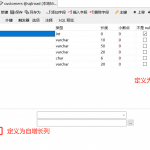一些适合新手学习的SQL基础语句汇总
DDL—数据定义语言(Create,Alter,Drop,DECLARE)
DML—数据操纵语言(Select,Delete,Update,Insert)
DCL—数据控制语言(GRANT,REVOKE,COMMIT,ROLLBACK)
1、说明:创建数据库
Create DATABASE database-name
2、说明:删除数据库
drop database dbname
3、说明:备份sql server
— 创建 备份数据的 device
USE master
EXEC sp_addumpdevice ‘disk’, ‘testBack’, ‘c:\mssql7backup\MyNwind_1.dat’
— 开始 备份
BACKUP DATABASE pubs TO testBack
4、说明:创建新表
create table tabname(col1 type1 [not null] [primary key],col2 type2 [not null],..)
根据已有的表创建新表:
A:create table tab_new like tab_old (使用旧表创建新表)
B:create table tab_new as select col1,col2… from tab_old definition only
5、说明:删除新表
drop table tabname
6、说明:增加一个列
Alter table tabname add column col type
注:列增加后将不能删除。DB2中列加上后数据类型也不能改变,唯一能改变的是增加varchar类型的长度。
7、说明:添加主键: Alter table tabname add primary key(col)
说明:删除主键: Alter table tabname drop primary key(col)
8、说明:创建索引:create [unique] index idxname on tabname(col….)
删除索引:drop index idxname
注:索引是不可更改的,想更改必须删除重新建。
9、说明:创建视图:create view viewname as select statement
删除视图:drop view viewname
10、说明:几个简单的基本的sql语句
选择:select * from table1 where 范围
插入:insert into table1(field1,field2) values(value1,value2)
删除:delete from table1 where 范围
更新:update table1 set field1=value1 where 范围
查找:select * from table1 where field1 like ‘%value1%’ —like的语法很精妙,查资料!
排序:select * from table1 order by field1,field2 [desc]
总数:select count as totalcount from table1
求和:select sum(field1) as sumvalue from table1
平均:select avg(field1) as avgvalue from table1
最大:select max(field1) as maxvalue from table1
最小:select min(field1) as minvalue from table1
11、说明:几个高级查询运算词
A: UNION 运算符
UNION 运算符通过组合其他两个结果表(例如 TABLE1 和 TABLE2)并消去表中任何重复行而派生出一个结果表。当 ALL 随 UNION 一起使用时(即 UNION ALL),不消除重复行。两种情况下,派生表的每一行不是来自 TABLE1 就是来自 TABLE2。
B: EXCEPT 运算符
EXCEPT 运算符通过包括所有在 TABLE1 中但不在 TABLE2 中的行并消除所有重复行而派生出一个结果表。当 ALL 随 EXCEPT 一起使用时 (EXCEPT ALL),不消除重复行。
C: INTERSECT 运算符
INTERSECT 运算符通过只包括 TABLE1 和 TABLE2 中都有的行并消除所有重复行而派生出一个结果表。当 ALL 随 INTERSECT 一起使用时 (INTERSECT ALL),不消除重复行。
注:使用运算词的几个查询结果行必须是一致的。
12、说明:使用外连接
A、left outer join:
左外连接(左连接):结果集几包括连接表的匹配行,也包括左连接表的所有行。
sql: select a.a, a.b, a.c, b.c, b.d, b.f from a LEFT OUT JOIN b ON a.a = b.c
B:right outer join:
右外连接(右连接):结果集既包括连接表的匹配连接行,也包括右连接表的所有行。
C:full outer join:
全外连接:不仅包括符号连接表的匹配行,还包括两个连接表中的所有记录。
13、说明:复制表(只复制结构,源表名:a 新表名:b) (Access可用)
法一:select * into b from a where 1<>1
法二:select top 0 * into b from a
14、说明:拷贝表(拷贝数据,源表名:a 目标表名:b) (Access可用)
insert into b(a, b, c) select d,e,f from b;
15、说明:跨数据库之间表的拷贝(具体数据使用绝对路径) (Access可用)
insert into b(a, b, c) select d,e,f from b in ‘具体数据库’ where 条件
例子:..from b in ‘”&Server.MapPath(“.”)&”\data.mdb” &”‘ where..
16、说明:子查询(表名1:a 表名2:b)
select a,b,c from a where a IN (select d from b ) 或者: select a,b,c from a where a IN (1,2,3)
17、说明:显示文章、提交人和最后回复时间
select a.title,a.username,b.adddate from table a,(select max(adddate) adddate from table where table.title=a.title) b
18.说明:外连接查询(表名1:a 表名2:b)
select a.a, a.b, a.c, b.c, b.d, b.f from a LEFT OUT JOIN b ON a.a = b.c
19、说明:在线视图查询(表名1:a )
select * from (Select a,b,c FROM a) T where t.a > 1;
20、说明:between的用法,between限制查询数据范围时包括了边界值,not between不包括
select * from table1 where time between time1 and time2
select a,b,c, from table1 where a not between 数值1 and 数值2
21、说明:in 的使用方法
select * from table1 where a [not] in (‘值1′,’值2′,’值4′,’值6′)
22、说明:两张关联表,删除主表中已经在副表中没有的信息
delete from table1 where not exists ( select * from table2 where
table1.field1=table2.field1 )
23、说明:四表联查问题:
select * from a left inner join b on a.a=b.b right inner join c on a.a=c.c inner join
d on a.a=d.d where …..
24、说明:日程安排提前五分钟提醒
sql: select * from 日程安排 where datediff(‘minute’,f开始时间,getdate())>5
25、说明:一条sql 语句搞定数据库分页
select top 10 b.* from (select top 20 主键字段,排序字段 from 表名 order by 排序字段 desc) a,表名 b where b.主键字段 = a.主键字段 order by a.排序字段
26、说明:前10条记录
select top 10 * form table1 where 范围
27、说明:选择在每一组b值相同的数据中对应的a最大的记录的所有信息(类似这样的用法可以用于论坛每月排行榜,每月热销产品分析,按科目成绩排名,等等.)
select a,b,c from tablename ta where a=(select max(a) from tablename tb where tb.b=ta.b)
28、说明:包括所有在 TableA 中但不在 TableB和TableC 中的行并消除所有重复行而派生出一个结果表
(select a from tableA ) except (select a from tableB) except (select a from tableC)
29、说明:随机取出10条数据
select top 10 * from tablename order by newid()
30、说明:随机选择记录
select newid()
31、说明:删除重复记录
Delete from tablename where id not in (select max(id) from tablename group by
col1,col2,…)
32、说明:列出数据库里所有的表名
select name from sysobjects where type=’U’
33、说明:列出表里的所有的
select name from syscolumns where id=object_id(‘TableName’)
34、说明:列示type、vender、pcs字段,以type字段排列,case可以方便地实现多重选择,类似 select 中的case。
select type,sum(case vender when ‘A’ then pcs else 0 end),sum(case vender when ‘C’ then pcs else 0 end),sum(case vender when ‘B’ then pcs else 0 end) FROM tablename group by type
显示结果:
type vender pcs
电脑 A 1
电脑 A 1
光盘 B 2
光盘 A 2
手机 B 3
手机 C 3
35、说明:初始化表table1
TRUNCATE TABLE table1
36、说明:选择从10到15的记录
select top 5 * from (select top 15 * from table order by id asc) table_别名 order by id desc
一些适合新手学习的SQL基础语句汇总介绍完毕。
本文由《MySql教程网》原创,转载请注明出处!https://mysql360.com







 苏公网安备32021302001419号
苏公网安备32021302001419号